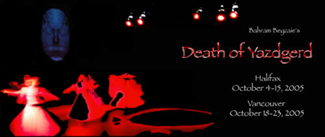Cresco


Written by Shahin Sayadi – original translation of Bahram Beyzaie’s Mard Yarzdgerd
Directed by Shahin Sayadi
Set design by Shahin Sayadi
Costume design by Shahin Sayadi and Joan Smith
Lighting design by Shahin Sayadi
Sound design by Shahin Sayadi
Stage Manager: Pip Bradford
Cast: Kevin Curran, Marty Burt, Janice Jackson, Anna MacLean, Pasha Ebrahimi
Other: Miya Turnbull (visual art and animation), Jake Dambergs (technical direction, video editing)
Yazdgerd III, of the Sassanid Dynasty, was the last of the Iranian kings before the Islamic era. During his reign, the Arab invasion of Iran intensified, and with his death in 651 A.D., a lengthy epoch in Iranian history came to an end.
The ancient Iranian calendar was a fragmented one. A new calendar started at the first year of the throning of a new King and ended with his death. The time period between the end of one era and the beginning of another, known as Shamiran, was indeed a period of chaos, disorientation and timelessness. This play is about a Shamiran. It depicts Day Zero of the Year Zero of the Iranian calendar- a time when an old order has collapsed and a new order has yet to emerge.
For ancient Iranians the King was a symbol of glory and divine destiny. And if a King’s glory was lost due to his misdeeds, his reign was doomed to collapse. In such event, it was a common belief that only the King’s death could spare the country from further disaster.
Death of Yazdgerd was originally written and performed in the unstable political and cultural aftermath of the 1979 Iranian revolution. Death of Yazdgerd deals with an historical event with a mysterious ending. When Islam was established in the Arabia, messengers were sent to four corners of the world to ask people to conform to the new religion. Upon receiving a negative response from the Persian Empire, Iran was attacked with great force by the Arabs. The army of Young Yazdgerd III was defeated and, in search of support, he rode east. Some time later, he was found dead in a flour mill and the miller was charged, by Yazdgerd’s ministers, with the King’s death.
In the turmoil of the Arab invasion of Persia, the doomed King, Yazdgerd, disappears only to be found, sometime later, dead in the house of a poor miller. As the King’s ministers and spiritual advisors attempt to understand what has happened, a variety of plausible stories emerge from the miller, his wife, and daughter, who are trying to exculpate themselves. As each member of the family takes turns describing, from the King’s perspective, what occurred, it becomes clear that both the mother and the daughter were victims of sexual violence at the hands of the King. To add to the confusion of events, the King has always been and is now masked; no one, including his closest advisors, can be sure that the dead man is actually the King or that the man claiming to be the miller is not, in fact, Yazdgerd. Throughout the play the concept of invasion serves as a thematic foundation. Islamic forces have invaded Persia; the King has invaded the miller’s house; the wife and daughter have been physically invaded, and even the masked personage of the King has not been untouched.
Death of Yazdgerd was built using our unique working philosophy, which included three workshops and public presentations.